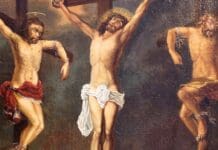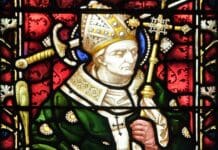 Legend has it that St. Vincent once stopped by the edge of a vineyard to talk with the men working there and while he was at it, his donkey nibbled at the young vine shoots. Come the next harvest, it was discovered that the vine stock that had been browsed had produced more fruit than all the others. St Vincent’s donkey had invented the art of vine pruning. This is one of the reasons that he is the patron saint of vine dressers; vinegar makers; vintners; wine growers; wine makers.
Legend has it that St. Vincent once stopped by the edge of a vineyard to talk with the men working there and while he was at it, his donkey nibbled at the young vine shoots. Come the next harvest, it was discovered that the vine stock that had been browsed had produced more fruit than all the others. St Vincent’s donkey had invented the art of vine pruning. This is one of the reasons that he is the patron saint of vine dressers; vinegar makers; vintners; wine growers; wine makers.
Vincent was ordained deacon by his friend St. Valerius of Zaragossa in Spain. The Roman emperors had published their edicts against the clergy in 303, and the following year against the laity. Vincent and his bishop were imprisoned in Valencia. Hunger and torture failed to break them. Like the youths in the fiery furnace (Book of Daniel, chapter three), they seemed to thrive on suffering.
Valerius was sent into exile, and Dacian, the Roman governor, now turned the full force of his fury on Vincent. Tortures that sound like those of World War II were tried. But their main effect was the progressive disintegration of Dacian himself. He had the torturers beaten because they failed.
Finally he suggested a compromise: Would Vincent at least give up the sacred books to be burned according to the emperor’s edict? He would not. Torture on the gridiron continued, the prisoner remaining courageous, the torturer losing control of himself. Vincent was thrown into a filthy prison cell—and converted the jailer. Dacian wept with rage, but strangely enough, ordered the prisoner to be given some rest.
Friends among the faithful came to visit him, but he was to have no earthly rest. When they finally settled him on a comfortable bed, he went to his eternal rest.
According to legend, after being martyted, ravens protected St. Vincent’s body from being devoured by wild animals, until his followers could recover the body. His body was taken to what is now known as Cape St. Vincent; a shrine was erected over his grave, which continued to be guarded by flocks of ravens. King Afonso Henriques (1139-1185) had the body of the saint exhumed in 1173 and brought it by ship to the Monastery of São Vicente de Fora in Lisbon and now St. Vincent is the patron of Lisbon, Portugal. This transfer of the relics is depicted on the coat of arms of Lisbon.

















Does anyone read these comments??? I have posted 3 previous times, PLEASE PUT THE DATES THAT THE ST LIVED early in the text. Sometimes they are omotted altogether THis is only good journalisim. It puts the article in context and gives more meaning to the reader
Hello Steve,
We have received your comments, and when available we try to use your suggestions concerning the dates of the livs of the saints to give context to the articles. Thank you and God Bless!
“stock” should be “stalk”
Actually, in vinyard terms…it is VINE STOCK or VINESTOCK. So it is correct. Google vine stock…see what comes up.
This speaks for itself.Thankx for the info.This is GREAT INFO!!!!!!!!!
It such a beautiful work your doing.Thankyou so much to teach christians about our saints life.
I agree with Renita, As a fairly new Catholic ( 17 years) I don’t know much about the saints. I was raised Lutheran and didn’t learn about them in school like many Catholics do. I really appreciate being able to learn about them.